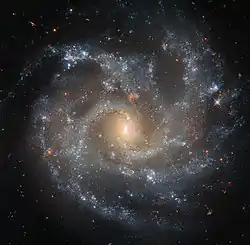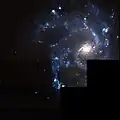| NGC 5468 | |
|---|---|
 NGC 5468 by Hubble Space Telescope | |
| Observation data (J2000 epoch) | |
| Constellation | Virgo |
| Right ascension | 14h 06m 34.9s[1] |
| Declination | −05° 27′ 11″[1] |
| Redshift | 0.009480 ± 0.000013[1] |
| Heliocentric radial velocity | 2,842 ± 4 km/s[1] |
| Distance | 138 ± 22.7 Mly (42.5 ± 7.0 Mpc)[1] |
| Apparent magnitude (V) | 12.5[2] |
| Characteristics | |
| Type | SAB(rs)cd[1] |
| Apparent size (V) | 2′.6 × 2′.4[1] |
| Other designations | |
| UGCA 384, MCG -01-36-007, PGC 50323[1] | |
NGC 5468 is an intermediate spiral galaxy located in the constellation Virgo. It is located at a distance of about 140 million light-years from Earth, which, given its apparent dimensions, means that NGC 5468 is about 110,000 light-years across. It was discovered by William Herschel on March 5, 1785.[3]
NGC 5468 has been home to six supernovae observed since 1999: SN 1999cp (type Ia, mag. 18.2),[4] SN 2002cr (type Ia, mag. 16.5),[5] SN 2002ed (type IIP, mag. 16.5),[6] SN 2005P (type Ia-pec, mag. 18.1),[7] SN 2018dfg (type IIb, mag. 15.9),[8][9] and SN 2023cj (type Ic, mag. 17).[10] NGC 5468 is seen face-on, and the spiral pattern is open. The two principal arms emanate from a small bar and start to branch into several thin fragments after some distance. Three large H II regions and some fainter ones can be seen in the images of the Carnegie Atlas of Galaxies.[11] These regions feature intense star formation. SN 2005P was located at the edge of one of these regions.[12]
NGC 5468 forms a non-interacting pair with NGC 5472, which lies at a projected distance of 5.1 arcminutes. NGC 5468 belongs to the NGC 5493 galaxy group. Other members of the group are the interacting pair Arp 271 (NGC 5426 and NGC 5427), NGC 5476, and NGC 5493.[13]
Gallery
 NGC 5468 by the HST
NGC 5468 by the HST
References
- 1 2 3 4 5 6 7 8 "NASA/IPAC Extragalactic Database". Results for NGC 5468. Retrieved 2016-01-18.
- ↑ "Revised NGC Data for NGC 5468". spider.seds.org. Retrieved 25 November 2018.
- ↑ Seligman, Courtney. "NGC 5468 (= PGC 50323)". Celestial Atlas. Retrieved 19 November 2018.
- ↑ Transient Name Server entry for SN 1999cp. Retrieved 27 June 2023.
- ↑ Transient Name Server entry for SN 2002cr. Retrieved 27 June 2023.
- ↑ Transient Name Server entry for SN 2002ed. Retrieved 27 June 2023.
- ↑ Transient Name Server entry for SN 2005P. Retrieved 27 June 2023.
- ↑ List of Supernovae IAU Central Bureau for Astronomical Telegrams. Retrieved 29 December 2015.
- ↑ "Bright Supernova pages - Most prolific galaxies". www.rochesterastronomy.org.
- ↑ Transient Name Server entry for SN 2023cj. Retrieved 10 January 2023.
- ↑ Sandage, A., Bedke, J. (1994), The Carnegie Atlas of Galaxies. Volume I, Carnegie Institution of Washington
- ↑ Lyman, J. D.; James, P. A.; Perets, H. B.; Anderson, J. P.; Gal-Yam, A.; Mazzali, P.; Percival, S. M. (September 2013). "Environment-derived constraints on the progenitors of low-luminosity Type I supernovae". Monthly Notices of the Royal Astronomical Society. 434 (1): 527–541. arXiv:1306.2474. Bibcode:2013MNRAS.434..527L. doi:10.1093/mnras/stt1038.
- ↑ Makarov, Dmitry; Karachentsev, Igor (21 April 2011). "Galaxy groups and clouds in the local (z∼ 0.01) Universe". Monthly Notices of the Royal Astronomical Society. 412 (4): 2498–2520. arXiv:1011.6277. Bibcode:2011MNRAS.412.2498M. doi:10.1111/j.1365-2966.2010.18071.x. S2CID 119194025. Archived from the original on 31 January 2016. Retrieved 2 December 2018.
External links
 Media related to NGC 5468 at Wikimedia Commons
Media related to NGC 5468 at Wikimedia Commons- NGC 5468 on WikiSky: DSS2, SDSS, GALEX, IRAS, Hydrogen α, X-Ray, Astrophoto, Sky Map, Articles and images